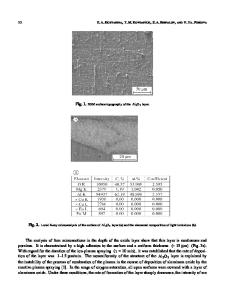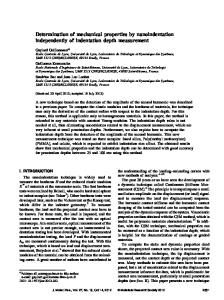Measurement of the micromechanical properties of nanostructured aggregates via nanoindentation
- PDF / 985,857 Bytes
- 13 Pages / 584.957 x 782.986 pts Page_size
- 0 Downloads / 378 Views
Depending on the application of nanoparticles, certain characteristics of the product quality such as size, morphology, abrasion resistance, specific surface, and tendency to agglomeration are important. These characteristics are a function of the physicochemical properties of the nanostructured material and, thus, of the process parameters of the particle synthesis. Because of econimical reasons in large-scale production such as pyrolysis or precipitation processes, nanosized particles are produced not as single primary particles but rather as aggregates or agglomerates. The application properties of these aggregates are strongly affected by the micromechanical properties, which can be measured via nanoindentation. In this study, a flat punch method was used. For the measurements, model aggregates out of sol–gel produced silica with varying primary particle size and strength of solid bonds were used. Generally, the micromechanical properties can be characterized by measuring the micromechanical properties via nanoindentation and be described by different theoretical models.
I. INTRODUCTION
In many cases, nanosized particles are not produced as single primary particles but rather as particle collectives consisting of several primary particles. In most applications, the particles have to be available in liquid as separately dispersed primary particles or at a certain aggregate size.1,2 Generally, the influencing factors for breaking up the aggregates depend on the grinding and dispersing process itself, as well as on the properties of the fluid and the aggregates itself. Especially, the micromechanical properties, like Young’s modulus, hardness, and plastic and elastic deformation energies, of nanostructured aggregates have a strong effect on the aggregate breaking behavior and on the dispersing process and the application properties. Basically, the material properties, the surface modification, the porosity, the structure, the particle size distribution, and the particle–particle interactions have a strong influence on the micromechanical properties. Basic research on plastic and elastic deformation as well as on breakage of aggregates by nanoindentation are done by Kendall and Weihs3 and Raichman et al.4 Kendall and Weihs3 observed elastic and plastic deformations of aggregates during compression tests. In their experiments, the total macroscopic behavior of aggregates was characterized but no information was obtained regarding the particle–particle interactions in the aggregates. Raichman et al.4 characterized the strength of individual small silver agglomerate fixed on a)
Address all correspondence to this author. e-mail: [email protected] DOI: 10.1557/jmr.2011.440 672
J. Mater. Res., Vol. 27, No. 4, Feb 28, 2012
a hard substrate by measuring via nanoindentation. In contrast to Kendall and Weighs, who examined the macroscopic agglomerate deformation behavior, Adams et al.5 tried to characterize the particle–particle interactions within colloidal, polymer-bonded silica coatings using a Berkovich indenter (three-sid
Data Loading...











